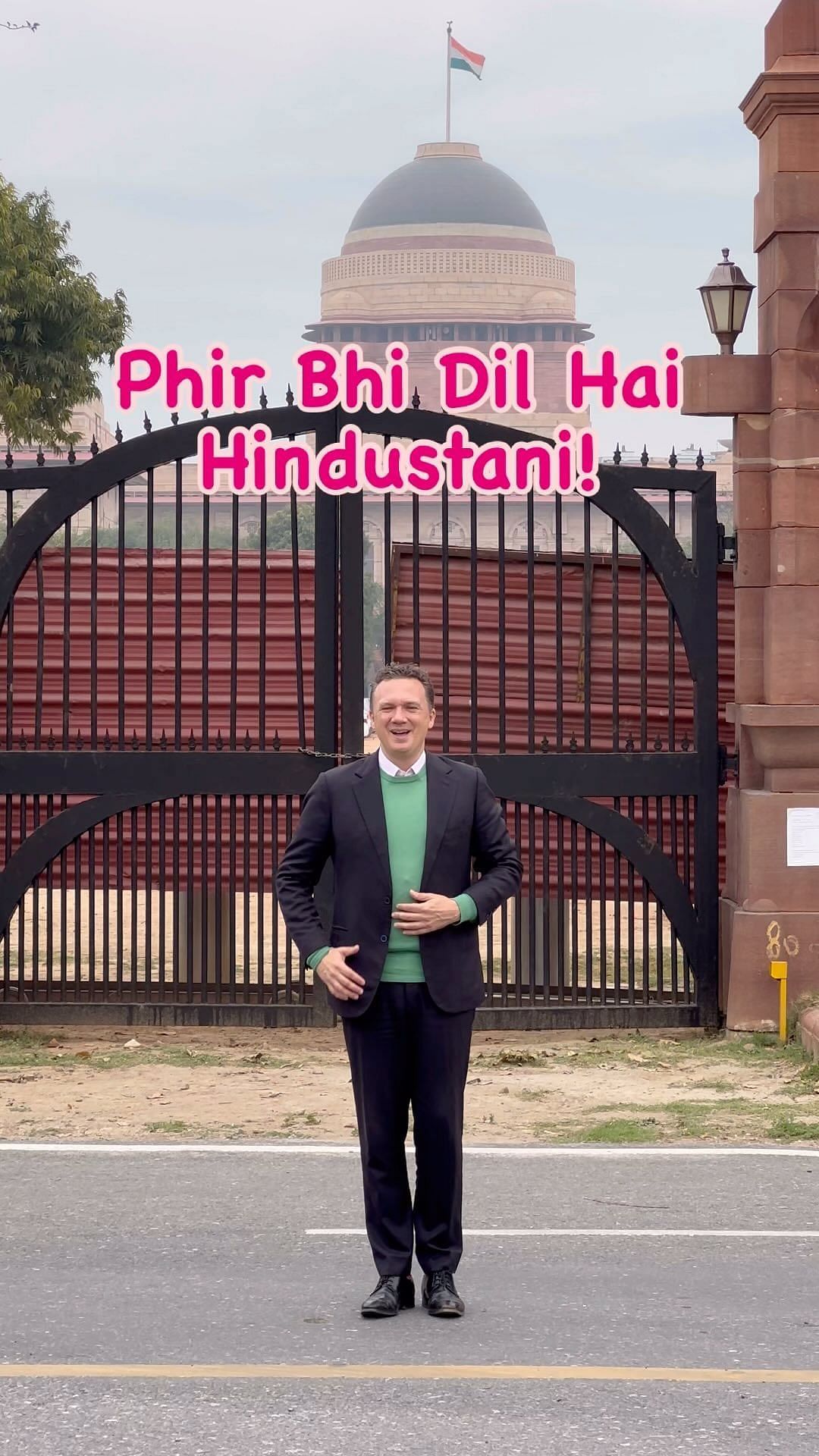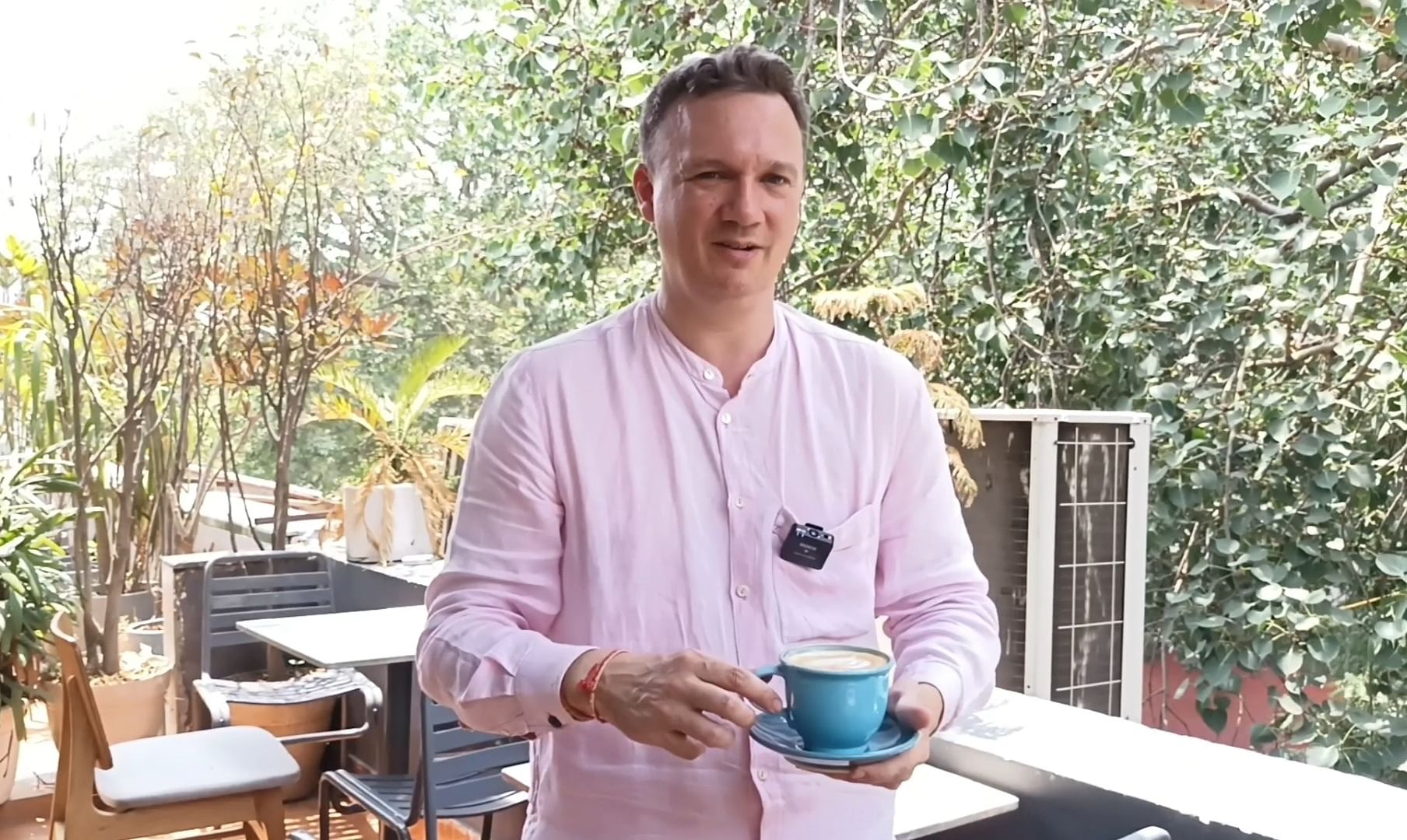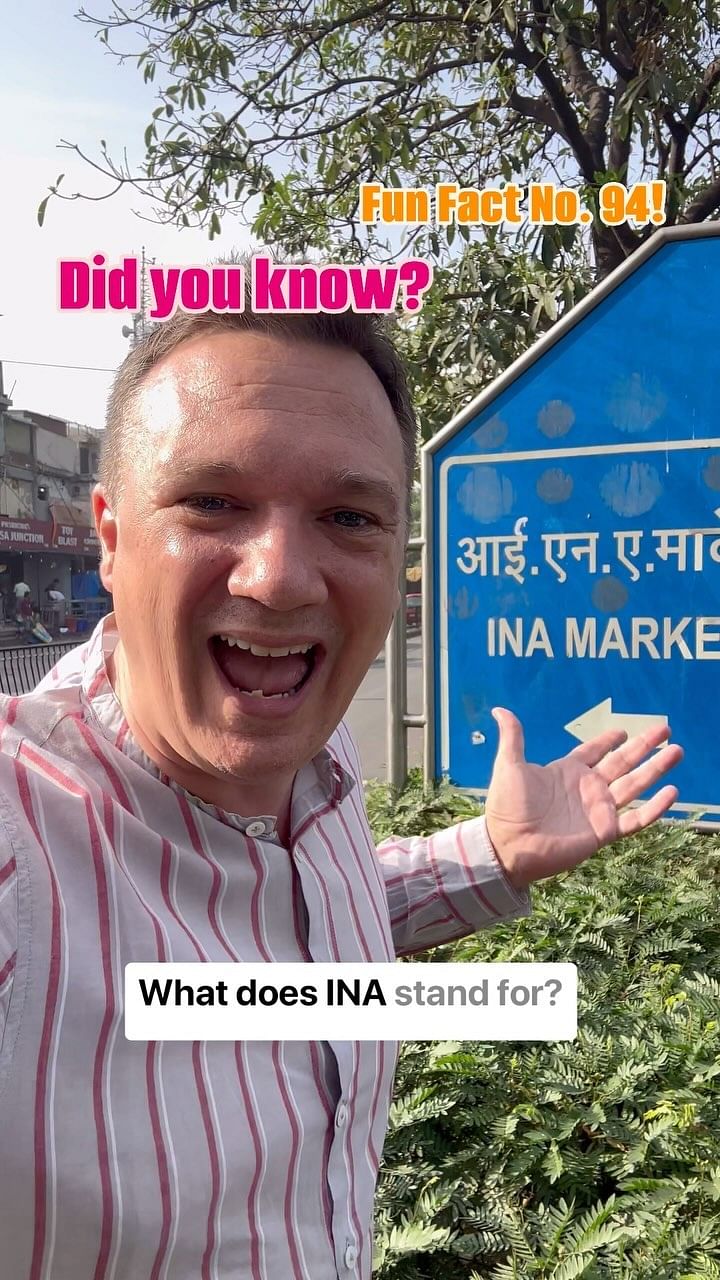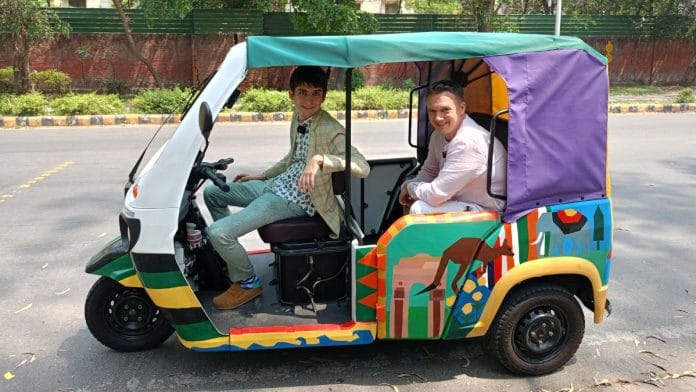New Delhi: Nick Booker can speak Hindi. He rolls filter coffee from tumbler to tumbler with a swish and a flick like a true-blue South Indian. He knows Delhi like the back of his hand, better than most Delhiites themselves. And now, the 43-year-old Englishman from Somerset has catapulted to social media fame. His USP is high-energy Instagram reels and short videos on the little nuggets of history and popular culture he has collected over the years.
“Did you know that one of the many mistakes the British made in India was the naming of this market on this road?” he says in one reel that has him standing outside a green Pandara Market signboard. “It should be called Pandava, afterthe Pandava brothers from the Mahabharata. A British clerk in the 1930s mistyped a V for an R.”
He has amassed 192K followers on Instagram (@indogenius), with some of his reels crossing a million views. The raw,unscripted energy, enthusiasm, and information in his reels set him apart from other expats and influencers tapping India for a global audience.
Booker joins a small tribe of expat content creators like YouTuber Karl Rock from New Zealand and American Hindi teacher Jessica Kumar, who are sharing their discovery of India with their followers around the world.
It became obvious to me that the 21st century would be about the re-emergence of India, economically, technologically and geopolitically. I also recognised that the most important re-emergence is that of the Indic worldview and civilisational perspective. Even before I got on the plane, I had convinced myself to spend the rest of my life here
— Nick Booker

Having lived in Delhi for 17 years, Booker, who works in the education sector, has seen the city change at breakneck speed.
“Delhi never ceases to amaze me. Its traffic might have increased, and some old favourites like the Hauz Khas market are no longer the same. But I love every bit of it, including its many trees—Semal, Gulmohar, Amaltas. The way they bloom and change as the months progress,” says Booker.
His reel on the origin of INA market was a breakthrough moment that had everyone talking about the foreigner telling the city’s residents about their own history. But Booker does not bracket himself to just history. His fascination with Delhi’s art, architecture, trees, and green spaces shines through, as does his love for Carnatic Cafe’s ragi dosa and Naga pork. It’s the one dish that tempts him to break his no-meat diet.
“Delhi has every kind of architecture, from Rajput and Mughal to art deco, gothic, and neo-classical even Punjabi Baroque. In each case the architecture is a statement imposing the vision of its patrons as the holders of power,” says Booker.
On a long, endless Delhi trail
These days, Booker has been travelling around the city in a brightly painted auto-rickshaw driven by Alistair Campbell, an Australian who now lives in Delhi.
A Wednesday morning finds them both outside the Australian High Commission in Chanakyapuri. They position themselves in front of a series of wall murals painted by Australian indigenous artist Aretha Brown in collaboration with the Aravani Art Project, a platform run by cis and trans-women.
Once, cops stopped me, and I thought it was to check if I have a licence. But instead, they wanted to take a selfie with me
— Alistair Campbell
“Namaste,” says Booker, joining his hands as the camera starts rolling. And with a wide smile, he jumps right into a conversation with Campbell on Australian dingoes and their connection to India.
“People with ancestors who had lived in India visited Australia nearly 4,000 years ago, and that’s when the first appearance of dingoes was also recorded for the first time,” says Booker. It’s possible that Indians may have introduced dingoes to Australia. From there, he moves to how Australian students exported the flat white coffee to other parts of the world.

Booker met Campbell and his wife Jade at the Sunder Nursery farmers market.
“They recognised me from some of my reels about Delhi and came over to say hi,” he says. They discovered their shared love for Delhi, its people, birds, and trees.
“We thought it would be fun to go out in his auto to make some reels about the relationship between Australia and India to encourage more Australian students to come and study in India,” Nick adds.
The sight of the three-wheeler with kangaroos painted on it chugging on Delhi’s roads leaves other auto drivers flabbergasted. When they see Campbell driving it with ease, their jaws drop.
“Once, cops stopped me, and I thought it was to check if I have a licence. But instead, they wanted to take a selfie with me,” says Campbell, chuckling.
The auto-darshan of Delhi has received a positive response from Booker’s followers, especially an earlier reel on Jantar Mantar. The conversational reel had 52k views, with suggestions about the places they can explore next.
Back in the auto, they drive by Lodhi Colony, and immediately Booker talks about Walter Sykes George, who, much like Booker, fell in love with India and spent his life in Delhi. He designed Lodhi Colony with its arches, open spaces, and pavements in the 1940s. “Lodi Colony was the last British residential project in India. It’s architect Walter Sykes George actually stayed on until his death in 1962. I love how his blank geometric walls have become canvasses for the fabulous street art,” said Booker.

INA, Candy—reels of the ‘genius’
Booker created his Instagram page @indogenius in 2015, but it was only in January this year that he started creating content on a regular basis.
“It took off, and has only grown over the moments,” said Booker, who also runs IndoGenius, a platform that conducts tours and projects for students from abroad so that they can get an immersive experience of India.
For content, he has travelled the length and breadth of India, from Kashmir to Kanyakumari, to dig out interesting information. One of his more recent adventures took him to a sweet shop in western Uttar Pradesh. It was the perfect backdrop for Booker to explain the Sanskrit roots of the word ‘candy’.
“…sugarcane was processed for the first time two and a half thousand years ago somewhere in India, possibly Bihar, maybe Uttar Pradesh. And when it was turned into these little fragments, the word in Sanskrit for fragment is ‘khand’. So, candy comes from the Sanskrit word khand because of the incredible technological innovation of the refining process of sugarcane to make it more easily transportable that happened here in Northern India.”
But his more popular reel to date is on INA, in which he explains that the acronym used for the famous market stands for Indian National Airways. The idea for the reel, which has been viewed 1.4 million times so far, started out with a conversation between him and his wife Meetu Soni.

“We had dropped our daughter at school, and I told Nick that he should make a reel on it, and that I would drive him there right now,” said Soni, who is also his business partner at IndoGenius.
He responds to comments and criticism with dry wit.
“I didn’t expect to get schooled about Delhi by a gay guy first thing in the morning but here we are. Love it,” an Instagram user commented. Booker did not miss a beat and replied, “Don’t tell my wife that.”
A long journey to India
Booker is at ease in Delhi—it’s now his village, his home. Almost every store owner in Khan Market, from the proprietors of Bahrisons and Faqir Chand to the managers of a local cafe (not managers, acquaintances he met outside a cafe) ,greet him with broad grins. These are connections he has built and nurtured over the years.
He grew up in a typical English countryside of Somerset, where the only connection to anything Indian was a cafe and a clothes store. He settled in London, working as a financial consultant. But he couldn’t ignore that gnawing sense of dissatisfaction to break free from the constraints of a regular office job. The move out of the UK slowly becameinevitable.
“It was hard for me to be optimistic about the future in the West generally, whether it was the ever-increasing debt piling up in companies, or the politics or even culture. I felt like the West was in a state of rapid decline,” says Booker.

At first, India was not his first choice, though he knew friends who had backpacked across the country. He spent six months researching other countries. He considered China, the US (specifically Silicon Valley), Argentina, Turkey, and New Zealand before circling back to India.
“It became obvious to me that the 21st century would be about the re-emergence of India, economically, technologically and geopolitically. I also recognised that the most important re-emergence is that of the Indic worldview and civilisational perspective. Even before I got on the plane, I had convinced myself to spend the rest of my life here,” said Booker.
He arrived in Delhi with two bags full of books.
That was in 2007. His first venture was advising organisations interested in real estate in India, and in 2009, with the Dubai economic crisis, Booker realised he needed to change course.
That started his journey of working with universities abroad seeking to expand their base in India, through academic and research collaborations.
We help governments, universities engage with India. Currently, 21 Australian universities are sending students to India several times a year, sponsored by the government under the New Colombo plan
— Nick Booker
In 2012, Booker customised a tour for a group of students, who spent time understanding Indian culture, academics,and the job market. He enjoyed it so much that he decided to jump into it full time and founded IndoGenius.
“We promote India around the world by engaging governments and universities. Our next project is an India study tour for students from 21 Australian universities. They’ve been sponsored by their government to learn about India with us under the prestigious New Colombo Plan,” says Booker.
Adopted country that became home
Over the course of his 17 years of stay in India, driven by a curiosity that is still intact, Booker made friends across communities and professions, listening to people as much as talking, and learning something new about his adopted country every day. His decision to spend the rest of his life in India was only strengthened when he met Soni.
It happened via a closed Facebook group aimed at making friends and new connections. An impromptu meeting between the two at Shalom, GK 1 culminated in a love story that saw four different weddings, from Somerset to a farmhouse in Chattarpur.
“He is a storyteller, and that made me fall in love with him,” says Soni. The duo took trips to Varanasi to witness the total solar eclipse, and then to Valley of Flowers in Chamoli (Uttarakhand) where Nick proposed.
The marriage only deepened his love for the country, his determination to help students across the world experience what he has, and meet new people to engage in intriguing conversations and collaborations.
Booker’s years in India inform his content. Viewers observe how comfortable he is in the heat and the rains, with the people and the food.
As Campbell deftly weaves his auto through Delhi’s streets towards Carnatic Cafe for a late lunch, Booker breaks into a grin. “My godfather had a passionate affair with an Indian whose name is given to one of the most exclusive roads in the city. But that’s a story for another reel!”






